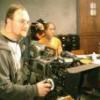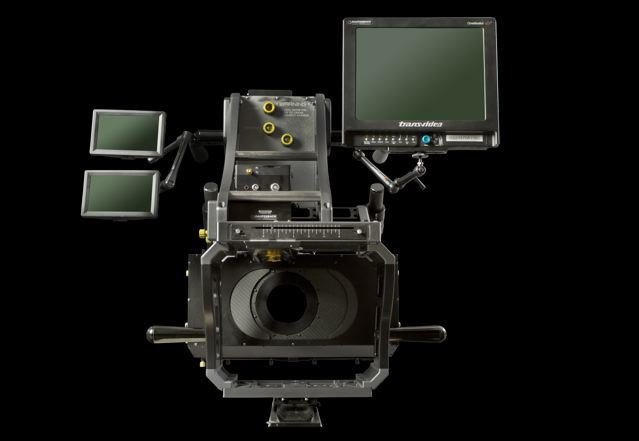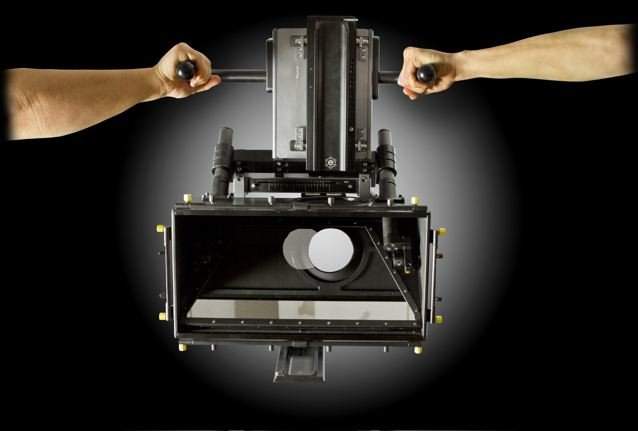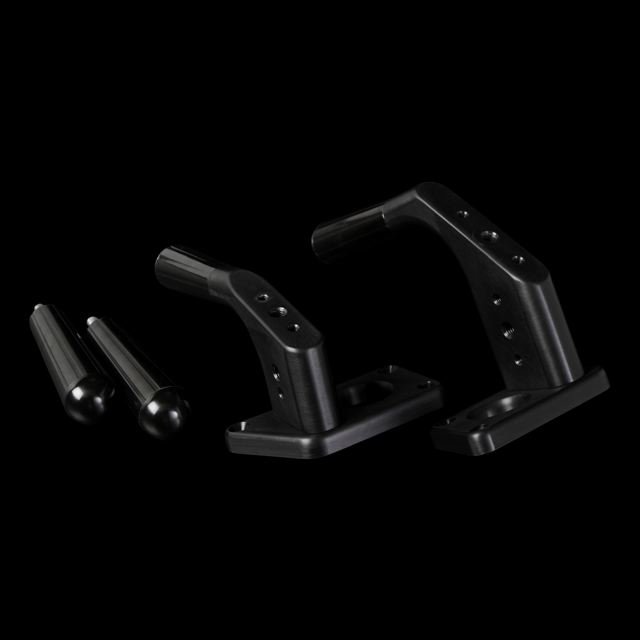-
Posts
49 -
Joined
-
Last visited
Posts posted by John Waterman
-
-
Hello there. I am a local 600 focus puller and a 3D rig tech, and I would be happy to answer your questions. There are a number of things to consider with focus and 3D. There are two cameras and two lens in a 3D beamsplitter rig. Each lens must be matched to the other in all aspects (focus, iris, and focal length). If you wish to pull focus during a shot, a common thing to do, then both lens have to pull together, and in perfect sync. The standard way to do this is to use motors to drive both lens, controlled with a lens control system. Cmotion has become the defacto standard LCS to use. The Cmotion Cvolution can control up to 8 motors, allowing for sync focus, iris, zoom, and rig IA and C controls. Most lens have some variation in the focus scale from unit to unit, so it is not enough to have the motors simply running at the same time. The Cmotion Cvolution can sync up to 32 points on the each scale. During my camera prep I calibrate the focus scales using the Cmotion so that each mark on the lens matches the other lens. (10' matches 10', 15' matches 15', 30' matches 30', etc). I do this for every lens pair and save the calibration to a usb thumb drive. The Cmotion has a wireless hand control that when properly set up will control both lens for focus, iris, and zoom. I own a 3D Cmotion Cvolution kit and would be happy to answer any more questions.
-
I second this: Please do not buy the redrock whips. I consider them worse than nothing at all as they are far too bendable to have any accuracy. Arri ones are good.
Just don't go cheap and get the RedRock ones. They're far too flimsy and springy, so you don't have precise control over hitting your marks. The ones I've used even curl up if you got any quick pulls.
-
As a DP, you should feel free to lean on your 1st AC to deal with all of the technical setup of the camera equipment. Your ACs will do all of that for you so that you can concentrate on lighting, blocking, camera movement, framing... If you want to be an artist then be an artist, your crew is behind you to make your visions come to life.
-
My question for you is, do you want to be a camera assistant (a technician), or a cinematographer (an artist). If you want to shoot, then go shoot. Work for free on weekends on craigslist shorts. Build up a reel. Do a spec shoot and rent a phantom and shoot some food. Build your reel and your contacts. I know many DPs that came up this way. Remember that people will most likely hire you for the same job that they hired you last for, so you end up working in one position. I love being an AC. I love everything technical about photography, cameras, and the process of making pictures. If AC work does not satisfy you in this way then you should not be an AC. Just my 2 cents.
-
I like to wear an under armour shirt as a base layer under my normal clothes. The "Cold Gear" shirts are best, but my "Heat Gear" works fine too.
-
-
As a 1st camera assistant and certified 3d rig technician, I have had the opportunity to work with the Element Technica Quasar Beamsplitter 3D camera rig to create stunning 3D pictures.
In an effort to help make 3D productions faster and easier for the camera team, I am offering the Water Horns, a set of four handles that mount to the Element Technica Quasar 3D rig without modification. These handles allow a fully built 3D camera (weighing 100+ pounds) to be easily and effectively repositioned while protecting the delicate alignment of the beamsplitter and cameras.
The Water Horns are also an effective and elegant mounting place for monitors, cinetapes and other camera accessories. By mounting the camera monitors to the Horns, the IO and convergence knobs are much easier to access for 3D alignment.
The Water Horns features:
• Attach with no modification to the Quasar frame
• Comfortable placement and grip
• Supports the 3D rig at its center of gravity
• Handy attachment points for monitors and camera accessories
• Handles can be removed quickly if needed
• Elegant contoured design
• Machined, anodized aluminum construction
• Cable-management clasp
Please check out my webpage at http://daufenbachcamera.com/waterhorns.php for pictures and details of these handles. I hope you and your clients will love these handles as much as we do! Best regards,
-
I got mine from the Hilti store in Chicago. Ask if they have any demo units for sale.
-
Yes, actually, quite well, even in bright sun. It is interesting, you can't see the dot with your naked eye, but if you look thru the sight it is very easy to spot.
With the sight, can you see the dot in full sun?
-
They are the same, except the 42 has the optical sight. I own the 42 and recommend it; the optical sight is very useful when working in daylight conditions.
-
I really like the OConnor 2065 fluid head. We have this for our Red One package, and it's great. It will balance your SRII camera perfectly, and all of the controls are similar/in the same location as the industry standard OConnor 2575.
-
By the way, professional systems don't have any vertical or horizontal adjustments. The right dimensions and positions for everything are machined in to the design.
Not entirely true. The Arri MB-20 mattebox system has adjustments for 3 axis, for a perfect fit on the lens.
-
As an example, here is a pic of my cinetape case. As you can see, they were able to cut a lot of details into the foam for a perfect fit.
-
I highly recommend "Innerspace Cases" (http://www.innerspacecases.com/) I had Innerspace make me a custom foam Pelican case for my cinetape system.
Where do you guys get foam for your pelican and flight cases in Los Angeles?
I just got a few cases for my personal gear and need to get some custom foam cut to fit.
-
I don't think using an iphone is the best solution, I'd much rather use a built in display. I'm wondering about power - what happens when you've been doing 6 hours of steadicam and the iphone battery runs out? Also what happens when you are pulling focus and get a phone call? or a txt message? Also makes the hand unit more fragile. Everything in the kit looks very low build quality, all plasticy.
I'd love to see them make something that is really production worthy, but cost a bit more. I'd pay $10,000 for a system if it was the build quality of a c-motion or preston.
Not a fan of the rip off cinetape either. The numeric display is built into the horns?? What if you are working from the dumb side? It makes much more sense to make the display seperate, like on a real cinetape.
-
I just upgraded my Disto A3 to a Hilti PD-42. I must say, the peep sight for day exterior work is really great. To answer your question, I use my hard-tape for measurements out to 8' or so, then its Hilti. I have a 50' cloth tape too, but it usually only comes out during the prep or for day exterior work where I can't see the laser dot. Now that I have the peep sight I plan on using the cloth tape very little.
-
In my experience a Red One in studio mode with on-board battery and large prime lens puts the 2060 head at 75%-80% counter balance capacity. with an Optomo 24-290 or other big zoom you need to go with a 2575.
Great to see another Rochester NY on this forum. I'm an RIT alum.
-
I can tell you that for me I really enjoyed film school, and feel I am a better AC because of it. In film school I learned about every discipline of filmmaking, and actively learned each job to an intermediate level. I am comfortable recording sound, editing, lighting, shooting, writing, directing, color grading, animating.. And because of my knowledge of all of the various filmmaking crafts I am able to understand and plan for the needs of other departments.
As an AC, I am preparing the footage and taking notes for the editorial department to use. I understand what they need to do their job, and can talk to them intelligently about workflow, codecs, EDLs, Metadata, proxies, off-line, online, color grading, etc.
For me film school was a time to explore the filmmaking process and to find my calling, I did not know I wanted to be an AC going in. Are there times when I wish I had just jumped in, yes, but over-all I think film school is a worthwhile experience, and will shape you in many subtle ways for the rest of your years.
-
Also no timecode slates? On a big show like that why no smartslate? Also the slate changes - including a very old school chalkboard slate.... Makes me wonder if that whole montage was shot "extra" to the real production, with the DVD in mind?
-
My favorite current use of focus is in “Children of Men” – When they are telling the story of Theo’s (Clive Owen) son and he is listening in on the story. The focus stays on Theo the whole scene, even though he is not the one talking. This selective focus really gets the audience to feel his reaction and emotions.
-
Any experience with R3D Data Manager? It seems like a well thought out program for this type of thing.
Do any of you keep paperwork of all these file transfers, like a post-camera log so to speak?
I'd like to chime in here. The emerging standard for all of these issues has been established by the ICG Data Handling workshop. I highly recommend this training for all L600 members.
For Red, R3D data manager is the standard. Make sure you use check sums when copying data from place to place to verify that it was copyed correctly. R3D data manager or shot put pro both create logs of every file transfer you make. Make sure to keep this 'reciept' if there ever is a question where/when data was copied.
The more copies the better. Make sure they are descrete seperate drives and live in different phyical locations. I recently day played on a Red indie feature where the digital loader had the second dive mirrored to the first drive, and the first drive got acedentally formated.. so it formated the second drive too, and production lost severals days of work. LTO tape back-ups are the best for ultimate archive.
Defitely go do the ICG training - two days of intensive study with the best people in the biz doing this kind of work.
-
It also has a small notch where a spring lock can click in place. I have some vague recollection of a noga arm where you press a button and lock it into an on-board monitor with this type of mating connection. Anyone know of on-board monitors or noga arms with this type of a connection?
-
Hello fellow ACs,
I just took delivery of a Cinetape Measure System, and noticed that the display has a wedge shaped cavity on the back to connect to a bracket or arm or something. I asked Cinematography Electronics about it, and they said that they were going to make a bracket for the display, but never did. I know I've seen this type of connector before somewhere, Panavision maybe?
Any ideas what can connect to this? I've attached a picture of the back of the cinetape.
-
You won't get 24v out unless it is supplied from the battery. As the CineTape inputs are either, the 3 pin will not supply 12v.
Can you clarify this for me William? The 3-pin out will only feed 24v out to the cinetape if a 24v power source is powering the camera. If the camera is being fed by a 12v source, like an AB batt, then the 11-pin out will be active and can feed the cinetape, right? The cinetape can input 24v or 12v.
I ordered both 3 pin and 11 pin cables for the cinetape just to be safe.








Cinebag and Modular51 alternatives
in Camera Assistant / DIT & Gear
Posted
Modular51 is no longer in business. Do not order from their website, they will take your money and never ship you a product. You can buy the bags they used to sell directly from the manufacturer: Fikenca. http://fikenca.com/index.php?option=com_phocagallery&view=category&id=1&Itemid=5